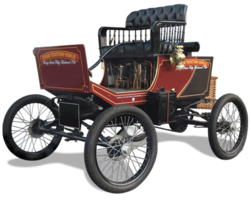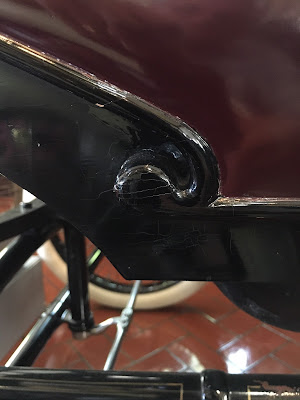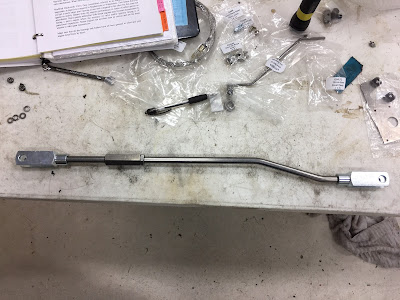Kit # 15 arrived mid January 2019 while I was away on our annual buying trip to Atlanta for our two retail gift shops here on Topsail Island. The instructions for this kit as a fellow Lyka builder stated to me is "a bit vague to say the least", and he is right. But thanks to Greg, and communication through the internet (and the Apple Empire!) all turned out well.
The first item was to install the reversing shaft bushings to the body frame boss. My bushings had a loose fit, so I used a little bearing sealant to fix them in place.
Next was to attach the Reverser Quadrant Bracket with four M6 Flat Head screws.
After letting my bearing sealant set up for a while, I assembled a thrust washer onto the brake handle and slid the brake handle into the boss.
Next was to assemble the Inner Brake Lever with a small key and fix this with a set screw. I had to adjust the depth of the keyway on the Inner Brake Lever due to a slight interference fit for these parts to slide together. I didn't want to force the parts together because I need to disassemble everything for final painting and finish.
Now the Reverser Lever is passed through the Brake Lever towards the Engine Support Frame and through the two bushing brackets.
Here we encounter my first fitting issue. As I have mentioned in a previous posting, the engine support frame is made from structural steel tubing. The tubing is not the best solution to rely upon for dimensional integrity. In the process of rolling the tubing into its rectangular shape at the steel manufacturing plant, there are inherent artifacts in that process that don't allow for nice square, parallel structure. Below you will see that the Reverser shaft is not parallel with the cross member frame. I took one measurement close to the Boss.
And then another measurement close to the brackets and as you can see below there is a significant difference -- about 0.080 inches (2mm).
Next I decided to unbolt the middle bracket from the engine support frame to see its alignment of the shaft through the remaining bracket.
Now the Reverser shaft measured parallel to the frame. So the issue mostly at this point is the middle bracket. A little "rat-tail" filing was in order.
Now comes my first encounter with the vagueness of the instructions. The instructions state to place the reverser lever between the two brackets with "a" 2mm washer (LK1475) on either side of the component. I did this and something didn't look right, too much slop!
At this point I consult Greg (fellow Lyka builder from France) because I know he had already completed Kit 15. He informed me that I was missing a few parts and set me straight. The assembly directions should have also instructed to use another 2mm washer LK1476 that has a slightly larger Outside Diameter (one is 30mm the other 32mm). The Reverser Lever actually has a 30mm side and a 32mm side diameter therefore matching washers. Also at this point I true up the engine support tube to make the brackets perpendicular and parallel to each other by filing the tube's rolled edge some.
Then the Bypass Rod Support Bushing is inserted into the Reverser Lever Shaft. I had to take about 0.001 inch off the diameter to get the bushing to a slide fit -- again I didn't want to force the fit.
Now I mount the brass reverser quadrant to the reverser bracket.
Next was to install the Reverser Rod Bypass Handle to the rod. I first try 15mm and test fit.
But I end up doing about 12mm.
And I used medium strength thread locker for the final assembly of the Bypass Handle to the rod.
This is now placed into the Reversing Lever Shaft and set with two M6 nuts (I had to use regular M6 nuts because my shipment of parts didn't have the half nuts (jam nuts) that were supposed to be sent. I will correct this in my final assembly with Stainless Steel hardware.
At this point I notice that the Parking Brake Lever will not fully seat into the brass quadrant. This will have to be corrected with a little filing of the lever in this area. When manufacturing and bending the lever to its specification, the steel actually deforms a little in this process which is easily fixed.
Onto mounting the ball valve and mounting bracket.
Another M6 nut is placed on the rod and a mating part that slides onto the ball valve stem and threaded to the rod is used. This part is referred to as the Bypass Actuator (LK1441N).
Now our instructions say to assemble the Reversing Rod that mounts to the Reversing Actuator and the Engine. It consists of two clevis', two threaded rods, a turn buckle or threaded adjuster and two M12 jam nuts (one left hand thread). The kit supplied regular M12 nuts, but I swapped them for some half nuts that I had.
The instruction says to loosen the engine reversing arm's set screws and rotate the arm so that the clevis can be installed. I chose not to do this at this time because I'm going to paint the assembly black. I did mount it to the reversing lever actuator for fit and slid the engine clevis over the engine reversing actuator as a test fit.
Valve Timing instructions were given in this kit, however Steam Traction World did not provide any means to hook up the engine by means of a manifold for compressed air as instructed for testing purposes. I skipped over this part and await parts in a subsequent kit before attempting to time the valves. Next the kit provided some of the parts for the lubrication system - again the instructions say to assemble and mount the lubricator, but no lubricator was supplied -- again this will follow in a subsequent kit. But the brackets and rod are mounted! (temporarily)
Finally this kit provided the cabling and parts for the Parking Brake.
First is to assemble the cable to the differential brake pad.
Then to route the cable through the pulleys. Here I find a design issue with the placement of one of the spacers for the middle pulley bracket. I removed this one spacer and bolt to allow the cable to pass through this bracket unimpeded.
But you will notice that the cable still rubs against the upper part of the bracket.
Also I notice on the smaller brake pulley that is mounted to the side frame that it too was rubbing the cable.
Therefore grinding, filing, tapping a new M8 into the middle bracket for the third spacer will solve these issues.
And a few final images of the brake cable assembled.
Now it is time to take all of this apart and paint everything that needs to be protected and reassemble. The next Kit 16 is another Boiler payment followed by Kit 17 the Boiler, so we think. I know Steam Traction World is busy welding the boilers, so hopefully it won't be too much longer before Kit 17 is ready for shipment.






























































































